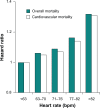Heart rate control with adrenergic blockade: clinical outcomes in cardiovascular medicine
- PMID: 20539841
- PMCID: PMC2882891
- DOI: 10.2147/vhrm.s10358
Heart rate control with adrenergic blockade: clinical outcomes in cardiovascular medicine
Abstract
The sympathetic nervous system is involved in regulating various cardiovascular parameters including heart rate (HR) and HR variability. Aberrant sympathetic nervous system expression may result in elevated HR or decreased HR variability, and both are independent risk factors for development of cardiovascular disease, including heart failure, myocardial infarction, and hypertension. Epidemiologic studies have established that impaired HR control is linked to increased cardiovascular morbidity and mortality. One successful way of decreasing HR and cardiovascular mortality has been by utilizing beta-blockers, because their ability to alter cell signaling at the receptor level has been shown to mitigate the pathogenic effects of sympathetic nervous system hyperactivation. Numerous clinical studies have demonstrated that beta-blocker-mediated HR control improvements are associated with decreased mortality in postinfarct and heart failure patients. Although improved HR control benefits have yet to be established in hypertension, both traditional and vasodilating beta-blockers exert positive HR control effects in this patient population. However, differences exist between traditional and vasodilating beta-blockers; the latter reduce peripheral vascular resistance and exert neutral or positive effects on important metabolic parameters. Clinical evidence suggests that attainment of HR control is an important treatment objective for patients with cardiovascular conditions, and vasodilating beta-blocker efficacy may aid in accomplishing improved outcomes.
Keywords: adrenergic beta-antagonists; heart failure; hypertension; myocardial infarction.
Figures





Similar articles
-
The Role of Beta-Blockers in the Treatment of Hypertension.Adv Exp Med Biol. 2017;956:149-166. doi: 10.1007/5584_2016_36. Adv Exp Med Biol. 2017. PMID: 27957711 Review.
-
Sympathetic activation and the role of beta-blockers in chronic heart failure.Aust N Z J Med. 1999 Jun;29(3):418-27. doi: 10.1111/j.1445-5994.1999.tb00737.x. Aust N Z J Med. 1999. PMID: 10868514 Review.
-
Effects of beta-blockers on glucose and lipid metabolism.Curr Med Res Opin. 2010 Mar;26(3):615-29. doi: 10.1185/03007990903533681. Curr Med Res Opin. 2010. PMID: 20067434 Review.
-
[EFFICACY OF ANTIARRHYTHMIC AGENTS UNDER CONDITIONS OF STIMULATION OF THE SYMPATHETIC NERVOUS SYSTEM.].Eksp Klin Farmakol. 2016;79(11):26-34. Eksp Klin Farmakol. 2016. PMID: 29791106 Review. Russian.
-
Does tight heart rate control improve beta-blocker efficacy? An updated analysis of the noncardiac surgical randomized trials.Anesth Analg. 2008 Apr;106(4):1039-48, table of contents. doi: 10.1213/ane.0b013e318163f6a9. Anesth Analg. 2008. PMID: 18349171
Cited by
-
Augmented rififylin is a risk factor linked to aberrant cardiomyocyte function, short-QT interval and hypertension.Hypertension. 2011 Apr;57(4):764-71. doi: 10.1161/HYPERTENSIONAHA.110.165803. Epub 2011 Feb 28. Hypertension. 2011. PMID: 21357277 Free PMC article.
-
Autoantibodies to the β(1)-Adrenoceptor from Patients with Periodontitis as a Risk Factor for Cardiac Dysfunction.ISRN Dent. 2011;2011:791393. doi: 10.5402/2011/791393. Epub 2011 Sep 7. ISRN Dent. 2011. PMID: 21991485 Free PMC article.
-
A Thermopile Sensor Revealed That the Average Peripheral Wrist Skin Temperature of Patients with Major Depressive Disorder at 09:00 Is 2.9 °C Lower than That of Healthy People.Sensors (Basel). 2025 Mar 5;25(5):1582. doi: 10.3390/s25051582. Sensors (Basel). 2025. PMID: 40096458 Free PMC article.
-
Periosteal pressure sensitivity of the chest bone as a measure for autonomic function in ischemic heart disease.Front Neurosci. 2025 May 21;19:1574942. doi: 10.3389/fnins.2025.1574942. eCollection 2025. Front Neurosci. 2025. PMID: 40470291 Free PMC article.
-
Brainstem dysfunction in critically ill patients.Crit Care. 2020 Jan 6;24(1):5. doi: 10.1186/s13054-019-2718-9. Crit Care. 2020. PMID: 31907011 Free PMC article. Review.
References
-
- Lanza GA, Fox K, Crea F. Heart rate: A risk factor for cardiac diseases and outcomes? Pathophysiology of cardiac diseases and the potential role of heart rate slowing. Adv Cardiol. 2006;43:1–16. - PubMed
-
- Lurje L, Wennerblom B, Tygesen H, Karlsson T, Hjalmarson A. Heart rate variability after acute myocardial infarction in patients treated with atenolol and metoprolol. Int J Cardiol. 1997;60(2):157–164. - PubMed
-
- Lonn E, Grewal J. Drug therapies in the secondary prevention of cardiovascular diseases: Successes, shortcomings and future directions. Curr Vasc Pharmacol. 2006;4(3):253–268. - PubMed
-
- Poulter NR, Dobson JE, Sever PS, Dahlof B, Wedel H, Campbell NR. Baseline heart rate, antihypertensive treatment, and prevention of cardiovascular outcomes in ASCOT (Anglo – Scandinavian Cardiac Outcomes Trial) J Am Coll Cardiol. 2009;54(13):1154–1161. - PubMed
-
- Frishman WH. A historical perspective on the development of β-adrenergic blockers. J Clin Hypertens. 2007;9(4 Suppl 3):19–27.
Publication types
MeSH terms
Substances
Grants and funding
LinkOut - more resources
Full Text Sources
Medical

